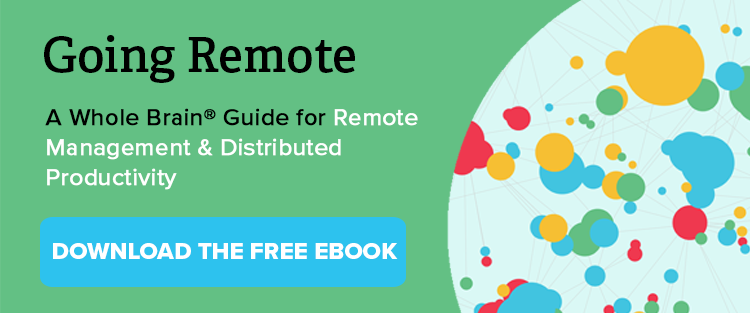With more of us working from home than ever before (and some of us for the very first time), we’ve all had to adapt to remote work and the complexities that come with it. How do we stay motivated when the couch and TV are mere metres away? How do we stay focused when the dog is jumping into our Zoom meetings and the kids are asking us for help with their schoolwork? And critically, how do we collaborate with our teammates when we’re not in the same building, and often not even working at the same time?
For many businesses, collaboration is often the key to success. But communication barriers in virtual settings make effective communication and teamwork understandably difficult. Fortunately, Whole Brain® Thinking gives us a framework to help us collaborate and communicate more effectively, whether we’re working with our colleagues side-by-side or virtually.
Here are some Whole Brain® tips to keep your virtual team working together and achieving their goals.
Communicate, communicate, communicate
For many A-quadrant and B-quadrant Thinkers, decision making and collaboration at work is driven by the rational – logic, facts and plans – rather than interpersonal relationships. But when it comes to working remotely, keeping the lines of communication open has never been more important. When we can’t physically be near each other, we need to ensure that we’re constantly communicating, via email, phone, Zoom call, instant messenger or other technologies, to keep projects running smoothly. Even if you’re quite comfortable locking yourself away for days without speaking to another living soul, keep in mind that even the slightest misunderstanding could go unchecked for days, meaning your carefully planned project could easily stray off course.
It’s also important to note that your C-quadrant teammates might be struggling with this change. Those that thrive on emotion and personal connection might not be dealing with the lack of communication during these times. And if one of your teammates is feeling unmotivated, disengaged and unproductive, it’ll affect your project and team morale. Make sure to reach out to your C-quadrant thinkers to keep them engaged in work.
Consider all the quadrants of the Whole Brain® Model when communicating across digital technologies
We all have different thinking styles. This makes collaboration challenging enough, even when we have non-virtual communication cues, such as tone of voice and body language, to help us interpret what our teammates are thinking. This is one of the reasons that miscommunication and misunderstandings are so common in text messages, emails and virtual conference calls.
The Whole Brain® Model provides a great framework to ensure conversations run smoothly across digital technologies. The key is to frame your communication by taking into account all four quadrants of the Whole Brain® Model. By doing this, you’re able to speak the language of all your teammates on your conference call, no matter how diverse their thinking styles.
To work with A-quadrant Thinkers, make sure you have the facts and figures to back up any of your points or decisions. To avoid misinterpretation over digital technologies, open with the data before you move on to meatier topics or briefings. Keep the content clear, factual and structured and make sure to summarise points throughout the meeting.
B-quadrant Thinkers seek out detailed plans and procedures. Make sure there are always agendas before any virtual meeting. During conference calls, present information clearly and make sure you’re across the finer details to back up any decisions made. All teammates will benefit from detailed planning before projects are started, but this is especially important for B-quadrant Thinkers.
It can be hard to stay engaged when working from home. This is especially true for C-quadrant Thinkers who thrive on interpersonal connection. When working and communicating with C-quadrant Thinkers, use stories and context to make more of an impact and to get them on board with a project.
D-quadrant Thinkers need the big picture. When working remotely, it can be hard to see how the work we’re focusing on contributes to a greater strategy or piece of work. That’s why providing context is so important when working in a remote team. Let your teammates know why the work they’re doing is so important, and what the larger picture looks like.
Use HBDI® Assessments as an extension for better understanding
If your team has already completed their HBDI® Assessments, why not set up a virtual team workshop to break up your routine? While we’re all using video conferencing to maintain the productivity of our work, we can easily forget informal development opportunities. These are so important for building trust and improving the effectiveness of our team’s collaboration. The discussions we can have with our colleagues using the insights from HBDI® Assessments can lead to stronger relationships, fewer misunderstandings and a higher-performing team.
Pick out some points from your team members’ profiles and get the team to match them to who they think the individual could be. You may be hesitant about this, but remember no thinking style is better or worse when it comes to Whole Brain® Thinking. Point this out to your team along the way, reminding them that it is simply a better understanding of each other that improves our output and that no style is better or worse.
You can put some creativity into this, and make sure the workshop gives participants a better understanding of oneself and others – all while providing a space for some much-needed laughter through these times. It’s amazing what an activity like this can do for the trust within our teams, our own sense of belonging and our overall well-being.
Leverage Whole Brain® Thinking to master virtual communication
Whole Brain® Thinking is an incredibly powerful tool that can help us find more effective ways to collaborate with our teammates, even when we’re not in the same building. When the COVID-19 crisis comes to an end, we can take these skills back into the office with us to help us better understand our teammates. And for those of us who intend to continue working remotely for some of our working week, these are skills we can continue to develop to ensure our virtual teams remain productive, engaged and highly collaborative.
For more tips from our company about working from home, download the e-book, “Going Remote: A Whole Brain® Guide For Remote Management & Distributed Productivity.”


